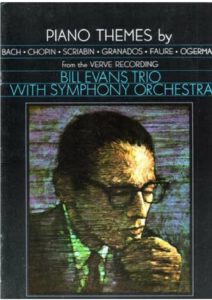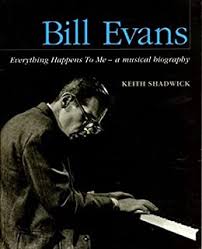Bill Evans (piano) Gone With The Wind (sheet music transcription available in our online Library)
William John Evans (August 16, 1929 – September 15, 1980) was an American jazz pianist and composer who mostly played in trios. His use of impressionist harmony, inventive interpretation of traditional jazz repertoire, block chords, and trademark rhythmically independent, “singing” melodic lines continue to influence jazz pianists today.Born in Plainfield, New Jersey, in 1929, he was classically trained at Southeastern Louisiana University and the Mannes School of Music, where he majored in composition and received the Artist Diploma.
In 1955, he moved to New York City, where he worked with bandleader and theorist George Russell. In 1958, Evans joined Miles Davis’s sextet, which in 1959, then immersed in modal jazz, recorded Kind of Blue, the best-selling jazz album of all time. During that time, Evans was also playing with Chet Baker for the album Chet.In late 1959, Evans left the Miles Davis band and began his career as a leader, with bassist Scott LaFaro and drummer Paul Motian, a group now regarded as a seminal modern jazz trio.

In 1961, ten days after finishing an engagement at the New York Village Vanguard jazz club, LaFaro died in a car accident. After months of seclusion, Evans reemerged with a new trio, featuring bassist Chuck Israels.In 1963, Evans recorded Conversations with Myself, a solo album using the unconventional technique of overdubbing himself.
In 1966, he met bassist Eddie Gómez, with whom he worked for 11 years.Many of Evans’s compositions, such as “Waltz for Debby”, have become standards, played and recorded by many artists. Evans received 31 Grammy nominations and seven awards, and was inducted into the Down Beat Jazz Hall of Fame.Bill Evans is seen as the main reformer of the harmonic language of jazz piano. Evans’s harmonic language was influenced by impressionist composers such as Claude Debussy and Maurice Ravel.
His versions of jazz standards, as well as his own compositions, often featured thorough reharmonisations. Musical features included added tone chords, modal inflections, unconventional substitutions, and modulations.An example of Evans’s harmonies. The chords feature extensions like 9ths and 13ths, are laid around middle C, have smooth voice leading, and leave the root to the bassist. Bridge of the first chorus of “Waltz for Debby” (mm.33-36). From the 1961 album of the same name.One of Evans’s distinctive harmonic traits is excluding the root in his chords, leaving this work to the bassist, played on another beat of the measure, or just left implied.

“If I am going to be sitting here playing roots, fifths and full voicings, the bass is relegated to a time machine.” This idea had already been explored by Ahmad Jamal, Erroll Garner, and Red Garland. In Evans’s system, the chord is expressed as a quality identity and a color. Most of Evans’s harmonies feature added note chords or quartal voicings. Thus, Evans created a self-sufficient language for the left hand, a distinctive voicing, that allowed the transition from one chord to the next while hardly having to move the hand.
With this technique, he created an effect of continuity in the central register of the piano. Lying around middle C, in this region the harmonic clusters sounded the clearest, and at the same time, left room for contrapuntal independence with the bass.Evans’s improvisations relied heavily on motivic development, either melodically or rhythmically. Motives may be broken and recombined to form melodies. Another characteristic of Evans’s style is rhythmic displacement. His melodic contours often describe arches. Other characteristics include sequenciation of melodies and transforming one motive into another.
He plays with one hand in the time signature of 4/4 and the other momentarily in 3/4.At the beginning of his career, Evans used block chords heavily. He later abandoned them in part. At least during his late years, Evans’s favorite keys to play in were A and E. Evans greatly valued Bach’s music, which influenced his playing style and which helped him gain good touch and finger independence. “Bach changed my hand approach to playing the piano.

I used to use a lot of finger technique when I was younger, and I changed over a weight technique.” Evans valued Bach’s “The Well-Tempered Clavier” and his “Two- and Three-Part Inventions” as excellent practice material.”Gone with the Wind” is a popular song. The music was written by Allie Wrubel, the lyrics by Herb Magidson, published in 1937.Whether the title of this song was related in any way to the 1936 Margaret Mitchell novel Gone with the Wind is difficult to determine. The timing of the song’s release suggests something more than coincidence, given that the book received enormous publicity in 1937, dominating the bestseller lists and winning a Pulitzer Prize. Still, the lyrics of the song have no obvious connection to the subject matter of the novel.
Best Jazz sheet music download here.
Browse in the Library:
Or browse in the categories menus & download the Library Catalog PDF:
